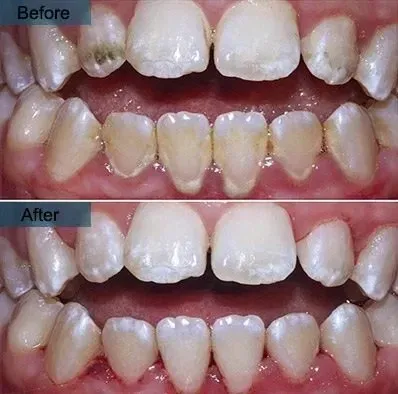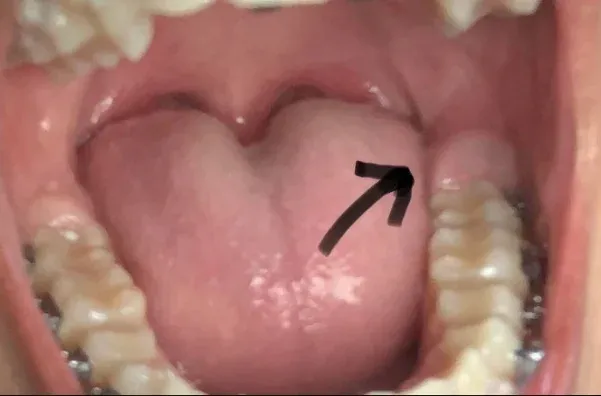Deep Cleaning Teeth Before and After with (Pictures) is it safe?
Maintaining good oral health is essential for overall well-being, and one crucial aspect of oral hygiene…
Maintaining good oral health is essential for overall well-being, and one crucial aspect of oral hygiene is regular dental cleanings. While routine cleanings are vital for most people, some individuals may require a more intensive procedure known as deep cleaning.
In this comprehensive guide, we will delve into deep cleaning teeth, both before and after the procedure. We will cover the following subheadings to provide you with valuable insights:

deep cleaning teeth before and after pictures:

What is Deep Cleaning Teeth?
Deep cleaning teeth, also known as scaling and root planing, is a dental procedure designed to remove stubborn plaque and tartar buildup from the surfaces of your teeth and below the gumline. Unlike a standard dental cleaning, which focuses on the visible surfaces of your teeth, deep cleaning targets the areas that are often missed during regular oral care routines.
The Process of Deep Cleaning
Deep cleaning typically involves two main steps:
- Scaling: The dental hygienist will use specialized instruments to carefully remove plaque and tartar from the tooth surfaces, including those below the gumline. This process helps eliminate the bacteria that can lead to gum disease.
- Root Planing: After scaling, the dentist will perform root planing to smooth the tooth roots. This helps prevent the reattachment of bacteria and promotes the healing of the gums.
When Do You Need a Deep Cleaning?
Not everyone requires deep cleaning, as it is typically recommended for individuals with specific oral health issues. The following situations may indicate a need for deep cleaning:
1. Gum Disease (Periodontitis):
Deep cleaning is commonly prescribed for individuals with gum disease, which includes symptoms like gum inflammation, bleeding, and gum recession. Gum disease occurs when bacteria-laden plaque and tartar accumulate below the gumline, causing infection and inflammation.
2. Excessive Tartar Buildup:
If you have a substantial amount of tartar (hardened plaque) on your teeth and below the gumline, your dentist may recommend deep cleaning to remove it effectively.
3. Periodic Maintenance:
Deep cleaning can also be part of a maintenance plan for individuals who have had gum disease in the past. Regular deep cleanings can help prevent the condition from worsening.
It’s crucial to consult your dentist for an assessment to determine if deep cleaning is necessary for your specific situation.
How to Prepare for a Deep Cleaning
Before undergoing a deep cleaning procedure, it’s essential to prepare both mentally and physically. Here are some steps to follow:
1. Schedule a Consultation:
Visit your dentist for an initial consultation and evaluation. This will allow them to assess your oral health and determine if deep cleaning is needed.
2. Review Your Medical History:
Provide your dentist with a comprehensive medical history, including any medications you are taking and any underlying medical conditions. This information can help ensure a safe and effective procedure.
3. Discuss Anesthesia Options:
Deep cleaning can be uncomfortable for some individuals, particularly if you have sensitive gums. Discuss anesthesia options with your dentist to manage discomfort during the procedure.
4. Plan for Recovery:
While deep cleaning is a non-invasive procedure, it’s essential to plan for a brief recovery period. You may experience some mild discomfort and swelling after the treatment, so make arrangements to take it easy for a day or two.
What to Expect During a Deep Cleaning
Understanding what happens during a deep cleaning can help ease any anxiety you may have about the procedure. Here’s what to expect:
1. Local Anesthesia:
Your dentist will administer a local anesthetic to numb the area being treated. This ensures you remain comfortable during the procedure.
2. Scaling:
The dental hygienist will use specialized instruments to remove plaque and tartar from the surfaces of your teeth and below the gumline. You may hear scraping sounds, but you should not experience pain due to the anesthesia.
3. Root Planing:
After scaling, your dentist will perform root planing to smooth the tooth roots. This process helps prevent bacteria from reattaching and promotes gum healing.
4. Post-Procedure Instructions:
Your dentist will provide you with specific post-procedure instructions. Follow these carefully to ensure a smooth recovery. These instructions may include recommendations for pain management, dietary restrictions, and oral care routines.
How to Care for Your Teeth After a Deep Cleaning
Proper aftercare is essential to support the healing process and maintain the results of your deep cleaning. Here’s how to care for your teeth after the procedure:
1. Oral Hygiene:
Continue to brush your teeth regularly, but be gentle around the treated areas. Use a soft-bristle toothbrush and avoid aggressive brushing that could irritate your gums.
2. Use a Mouth Rinse:
Your dentist may recommend an antimicrobial mouth rinse to reduce the risk of infection and support gum healing. Follow the instructions provided for the rinse.
3. Avoid Certain Foods:
Stick to soft, non-irritating foods for the first few days after your deep cleaning. Avoid hot, spicy, and crunchy foods that may aggravate your gums.
4. Attend Follow-Up Appointments:
Your dentist may schedule follow-up appointments to monitor your progress and ensure that your gums are healing as expected. It’s crucial to attend these appointments as scheduled.
Tips for Maintaining Good Oral Health:
Maintaining good oral health is essential to prevent the need for deep cleaning and other dental procedures. Here are some tips for keeping your teeth and gums healthy:
1. Regular Dental Checkups:
Schedule routine dental checkups and cleanings at least every six months to detect and address oral health issues early.
2. Daily Oral Care:
Brush your teeth at least twice a day and floss daily to remove plaque and prevent tartar buildup.
3. Healthy Diet:
Consume a balanced diet rich in fruits, vegetables, and calcium. Avoid excessive sugary and acidic foods and beverages.
4. Quit Smoking:
If you smoke, consider quitting. Smoking is a significant risk factor for gum disease and other oral health problems.
5. Stay Hydrated:
Drink plenty of water throughout the day to help flush away food particles and bacteria.
Deep Cleaning Teeth: Benefits and Results
Deep cleaning offers several benefits for individuals with gum disease and excessive tartar buildup. Here are some of the key advantages:
1. Gum Disease Management:
Deep cleaning is a critical component of treating gum disease. It helps remove the source of infection and inflammation, allowing the gums to heal.
2. Improved Oral Health:
By eliminating stubborn plaque and tartar, deep cleaning helps improve overall oral health and reduces the risk of tooth loss.
3. Preventing Tooth Mobility:
In cases of advanced gum disease, teeth can become mobile or loose. Deep cleaning can help stabilize teeth and prevent them from shifting.
4. Fresher Breath:
Removing bacteria and debris from below the gumline can lead to fresher breath and improved oral hygiene.
5. Preventing Complications:
Untreated gum disease can lead to severe complications, including tooth loss and systemic health issues. Deep cleaning helps prevent these complications.
In conclusion, deep cleaning teeth is a vital dental procedure designed to address specific oral health concerns such as gum disease and stubborn tartar buildup.
By understanding when it is needed, how to prepare for it, and what to expect during and after the procedure, individuals can take proactive steps to maintain their oral health. Following proper aftercare instructions and adopting a consistent oral hygiene routine can help ensure the success of deep cleaning and contribute to long-term dental wellness.
Regular dental checkups and a commitment to good oral hygiene remain the cornerstones of a healthy smile, preventing the need for more intensive treatments like deep cleaning in the future.







